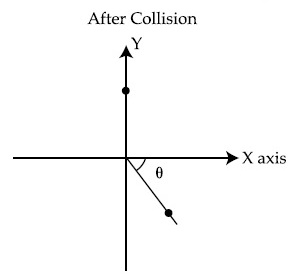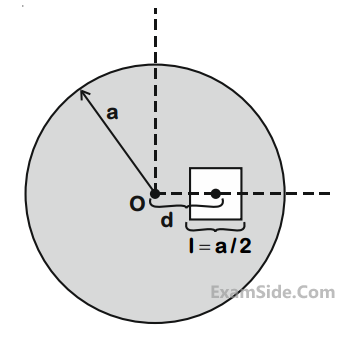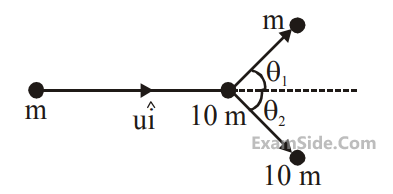Center of Mass and Collision · Physics · JEE Main
MCQ (Single Correct Answer)
A rod of length 5 L is bent right angle keeping one side length as 2 L .

The position of the centre of mass of the system :
(Consider $\mathrm{L}=10 \mathrm{~cm}$)

Consider two blocks A and B of masses $m_1=10 \mathrm{~kg}$ and $\mathrm{m}_2=5 \mathrm{~kg}$ that are placed on a frictionless table. The block A moves with a constant speed $v=3 \mathrm{~m} / \mathrm{s}$ towards the block B kept at rest. A spring with spring constant $\mathrm{k}=3000 \mathrm{~N} / \mathrm{m}$ is attached with the block B as shown in the figure. After the collision, suppose that the blocks A and B, along with the spring in constant compression state, move together, then the compression in the spring is, (Neglect the mass of the spring)

Three equal masses $m$ are kept at vertices $(A, B, C)$ of an equilateral triangle of side a in free space. At $t=0$, they are given an initial velocity $\overrightarrow{V_A}=V_0 \overrightarrow{A C}, \overrightarrow{V_B}=V_0 \overrightarrow{B A}$ and $\overrightarrow{V_C}=V_0 \overrightarrow{C B}$. Here, $\overrightarrow{A C}, \overrightarrow{C B}$ and $\overrightarrow{B A}$ are unit vectors along the edges of the triangle. If the three masses interact gravitationally, then the magnitude of the net angular momentum of the system at the point of collision is :
Given below are two statements. One is labelled as Assertion (A) and the other is labelled as Reason (R).
Assertion (A):  Three identical spheres of same mass undergo one dimensional motion as shown in figure with initial velocities $v_{\mathrm{A}}=5 \mathrm{~m} / \mathrm{s}, v_{\mathrm{B}}=2 \mathrm{~m} / \mathrm{s}, v_{\mathrm{C}}=4 \mathrm{~m} / \mathrm{s}$. If we wait sufficiently long for elastic collision to happen, then $v_{\mathrm{A}}=4 \mathrm{~m} / \mathrm{s}, v_{\mathrm{B}}=2 \mathrm{~m} / \mathrm{s}$, $v_{\mathrm{C}}=5 \mathrm{~m} / \mathrm{s}$ will be the final velocities.
Three identical spheres of same mass undergo one dimensional motion as shown in figure with initial velocities $v_{\mathrm{A}}=5 \mathrm{~m} / \mathrm{s}, v_{\mathrm{B}}=2 \mathrm{~m} / \mathrm{s}, v_{\mathrm{C}}=4 \mathrm{~m} / \mathrm{s}$. If we wait sufficiently long for elastic collision to happen, then $v_{\mathrm{A}}=4 \mathrm{~m} / \mathrm{s}, v_{\mathrm{B}}=2 \mathrm{~m} / \mathrm{s}$, $v_{\mathrm{C}}=5 \mathrm{~m} / \mathrm{s}$ will be the final velocities.
Reason (R): In an elastic collision between identical masses, two objects exchange their velocities.
In the light of the above statements, choose the correct answer from the options given below:
As shown below, bob A of a pendulum having massless string of length 'R' is released from 60° to the vertical. It hits another bob B of half the mass that is at rest on a frictionless table in the center. Assuming elastic collision, the magnitude of the velocity of bob A after the collision will be (take g as acceleration due to gravity.)
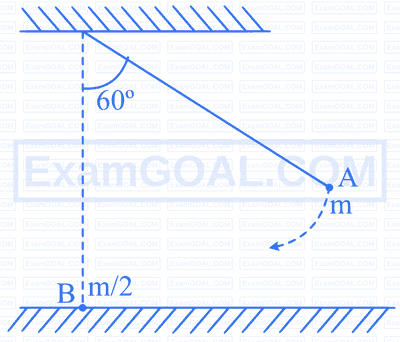
The center of mass of a thin rectangular plate (fig - x ) with sides of length $a$ and $b$, whose mass per unit area $(\sigma)$ varies as $\sigma=\frac{\sigma_0 x}{a b}$ (where $\sigma_0$ is a constant), would be __________.

Consider a circular disc of radius 20 cm with centre located at the origin. A circular hole of radius 5 cm is cut from this disc in such a way that the edge of the hole touches the edge of the disc. The distance of centre of mass of residual or remaining disc from the origin will be
A stationary particle breaks into two parts of masses $$m_A$$ and $$m_B$$ which move with velocities $$v_A$$ and $$v_B$$ respectively. The ratio of their kinetic energies $$\left(K_B: K_A\right)$$ is :
An artillery piece of mass $$M_1$$ fires a shell of mass $$M_2$$ horizontally. Instantaneously after the firing, the ratio of kinetic energy of the artillery and that of the shell is:
A spherical body of mass $$100 \mathrm{~g}$$ is dropped from a height of $$10 \mathrm{~m}$$ from the ground. After hitting the ground, the body rebounds to a height of $$5 \mathrm{~m}$$. The impulse of force imparted by the ground to the body is given by : (given, $$\mathrm{g}=9.8 \mathrm{~m} / \mathrm{s}^2$$)
Two bodies of mass $$4 \mathrm{~g}$$ and $$25 \mathrm{~g}$$ are moving with equal kinetic energies. The ratio of magnitude of their linear momentum is :
A body of mass $$1000 \mathrm{~kg}$$ is moving horizontally with a velocity $$6 \mathrm{~m} / \mathrm{s}$$. If $$200 \mathrm{~kg}$$ extra mass is added, the final velocity (in $$\mathrm{m} / \mathrm{s}$$) is:
A bullet of $$10 \mathrm{~g}$$ leaves the barrel of gun with a velocity of $$600 \mathrm{~m} / \mathrm{s}$$. If the barrel of gun is $$50 \mathrm{~cm}$$ long and mass of gun is $$3 \mathrm{~kg}$$, then value of impulse supplied to the gun will be :
An average force of $$125 \mathrm{~N}$$ is applied on a machine gun firing bullets each of mass $$10 \mathrm{~g}$$ at the speed of $$250 \mathrm{~m} / \mathrm{s}$$ to keep it in position. The number of bullets fired per second by the machine gun is :
A particle of mass m moving with velocity v collides with a stationary particle of mass 2m. After collision, they stick together and continue to move together with velocity
100 balls each of mass $$\mathrm{m}$$ moving with speed $$v$$ simultaneously strike a wall normally and reflected back with same speed, in time $$\mathrm{t ~s}$$. The total force exerted by the balls on the wall is
As per the given figure, a small ball P slides down the quadrant of a circle and hits the other ball Q of equal mass which is initially at rest. Neglecting the effect of friction and assume the collision to be elastic, the velocity of ball Q after collision will be :
(g = 10 m/s2)
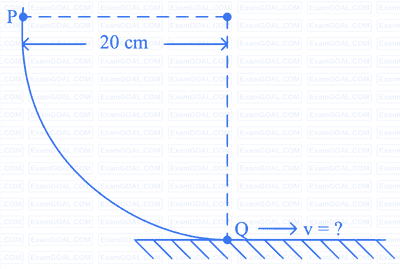
The figure represents the momentum time ($$\mathrm{p}-\mathrm{t}$$) curve for a particle moving along an axis under the influence of the force. Identify the regions on the graph where the magnitude of the force is maximum and minimum respectively?
If $$\left(t_{3}-t_{2}\right) < t_{1}$$

A ball of mass $$200 \mathrm{~g}$$ rests on a vertical post of height $$20 \mathrm{~m}$$. A bullet of mass $$10 \mathrm{~g}$$, travelling in horizontal direction, hits the centre of the ball. After collision both travels independently. The ball hits the ground at a distance $$30 \mathrm{~m}$$ and the bullet at a distance of $$120 \mathrm{~m}$$ from the foot of the post. The value of initial velocity of the bullet will be (if $$g=10 \mathrm{~m} / \mathrm{s}^{2}$$) :
If momentum of a body is increased by 20%, then its kinetic energy increases by
Two bodies of mass $$1 \mathrm{~kg}$$ and $$3 \mathrm{~kg}$$ have position vectors $$\hat{i}+2 \hat{j}+\hat{k}$$ and $$-3 \hat{i}-2 \hat{j}+\hat{k}$$ respectively. The magnitude of position vector of centre of mass of this system will be similar to the magnitude of vector :
In two different experiments, an object of mass $$5 \mathrm{~kg}$$ moving with a speed of $$25 \mathrm{~ms}^{-1}$$ hits two different walls and comes to rest within (i) 3 second, (ii) 5 seconds, respectively. Choose the correct option out of the following :
A body of mass $$10 \mathrm{~kg}$$ is projected at an angle of $$45^{\circ}$$ with the horizontal. The trajectory of the body is observed to pass through a point $$(20,10)$$. If $$\mathrm{T}$$ is the time of flight, then its momentum vector, at time $$\mathrm{t}=\frac{\mathrm{T}}{\sqrt{2}}$$, is _____________.
[Take $$\mathrm{g}=10 \mathrm{~m} / \mathrm{s}^{2}$$ ]
A ball of mass $$0.15 \mathrm{~kg}$$ hits the wall with its initial speed of $$12 \mathrm{~ms}^{-1}$$ and bounces back without changing its initial speed. If the force applied by the wall on the ball during the contact is $$100 \mathrm{~N}$$, calculate the time duration of the contact of ball with the wall.
A body of mass $$8 \mathrm{~kg}$$ and another of mass $$2 \mathrm{~kg}$$ are moving with equal kinetic energy. The ratio of their respective momentum will be :
Two billiard balls of mass 0.05 kg each moving in opposite directions with 10 ms$$-$$1 collide and rebound with the same speed. If the time duration of contact is t = 0.005 s, then what is the force exerted on the ball due to each other?
Two bodies A and B of masses 5 kg and 8 kg are moving such that the momentum of body B is twice that of the body A. The ratio of their kinetic energies will be :
A body of mass M at rest explodes into three pieces, in the ratio of masses 1 : 1 : 2. Two smaller pieces fly off perpendicular to each other with velocities of 30 ms$$-$$1 and 40 ms$$-$$1 respectively. The velocity of the third piece will be :
Two blocks of masses 10 kg and 30 kg are placed on the same straight line with coordinates (0, 0) cm and (x, 0) cm respectively. The block of 10 kg is moved on the same line through a distance of 6 cm towards the other block. The distance through which the block of 30 kg must be moved to keep the position of centre of mass of the system unchanged is :
What percentage of kinetic energy of a moving particle is transferred to a stationary particle when it strikes the stationary particle of 5 times its mass?
(Assume the collision to be head-on elastic collision)
An object is thrown vertically upwards. At its maximum height, which of the following quantity becomes zero?

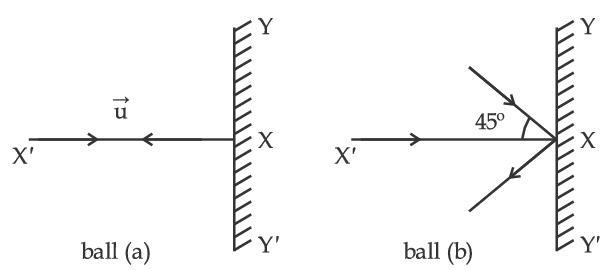

(take g = 9.8 ms-2)
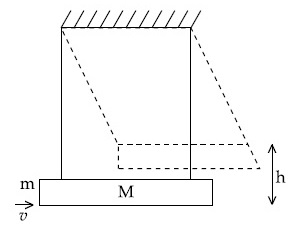
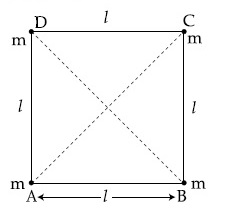
Assertion A : Body 'P' having mass M moving with speed 'u' has head-on collision elastically with another body 'Q' having mass 'm' initially at rest. If m << M, body 'Q' will have a maximum speed equal to '2u' after collision.
Reason R : During elastic collision, the momentum and kinetic energy are both conserved.
In the light of the above statements, choose the most appropriate answer from the options given below :

collision $$\overrightarrow {{V_1}} = $$$$\left( {\widehat i + \sqrt 3 \widehat j} \right)$$ , the angle between $$\overrightarrow {{V_1}} $$ and $$\overrightarrow {{V_2}} $$ is :

(take g = 10 m/s2)

density given by $$\rho $$(x) = $$a + b{\left( {{x \over L}} \right)^2}$$ , where a
and b are constants and 0 $$ \le $$ x $$ \le $$ L. The value
of x for the centre of mass of the rod is at :
initial velocities $$u\widehat i$$ and $$u\left( {{{\widehat i + \widehat j} \over 2}} \right)$$.
They collide completely inelastically. The energy lost in the process is :



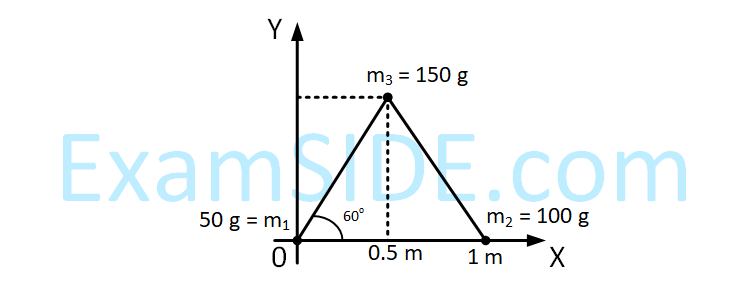

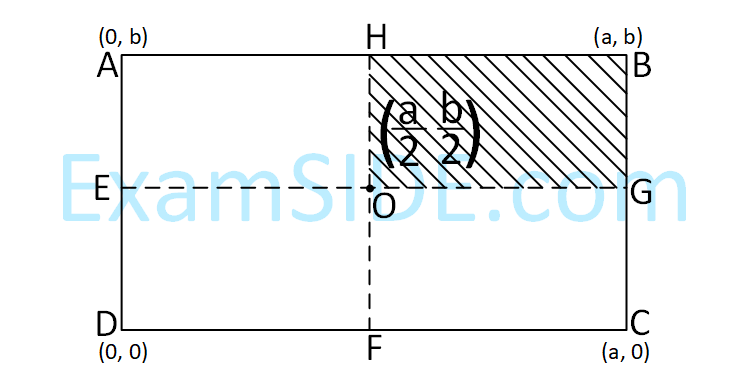






Statement - $${\rm I}$$: A point particle of mass $$m$$ moving with speed $$\upsilon $$ collides with stationary point particle of mass $$M.$$ If the maximum energy loss possible is given as $$f\left( {{1 \over 2}m{v^2}} \right)$$, then $$f = \left( {{m \over {M + m}}} \right).$$
Statement - $${\rm II}$$: Maximum energy loss occurs when the particles get stuck together as a result of the collision.
Statement - 2 : Principle of conservation of momentum holds true for all kinds of collisions.




$$A.$$ Linear momentum of a system of particles is zero
$$B.$$ Kinetic energy of a system of particles is zero.
then
Numerical
A uniform thin metal plate of mass $$10 \mathrm{~kg}$$ with dimensions is shown. The ratio of $$\mathrm{x}$$ and y coordinates of center of mass of plate in $$\frac{n}{9}$$. The value of $$n$$ is ________.

In a system two particles of masses $$m_1=3 \mathrm{~kg}$$ and $$m_2=2 \mathrm{~kg}$$ are placed at certain distance from each other. The particle of mass $$m_1$$ is moved towards the center of mass of the system through a distance $$2 \mathrm{~cm}$$. In order to keep the center of mass of the system at the original position, the particle of mass $$m_2$$ should move towards the center of mass by the distance _________ $$\mathrm{cm}$$.
A solid circular disc of mass $$50 \mathrm{~kg}$$ rolls along a horizontal floor so that its center of mass has a speed of $$0.4 \mathrm{~m} / \mathrm{s}$$. The absolute value of work done on the disc to stop it is ________ J.
A body starts falling freely from height $$H$$ hits an inclined plane in its path at height $$h$$. As a result of this perfectly elastic impact, the direction of the velocity of the body becomes horizontal. The value of $$\frac{H}{h}$$ for which the body will take the maximum time to reach the ground is __________.
The momentum of a body is increased by $$50 \%$$. The percentage increase in the kinetic energy of the body is ___________ $$\%$$.
A body of mass 1 kg collides head on elastically with a stationary body of mass 3 kg. After collision, the smaller body reverses its direction of motion and moves with a speed of 2 m/s. The initial speed of the smaller body before collision is ___________ ms$$^{-1}$$.
The distance of centre of mass from end A of a one dimensional rod (AB) having mass density $$\rho=\rho_{0}\left(1-\frac{x^{2}}{L^{2}}\right) \mathrm{kg} / \mathrm{m}$$ and length L (in meter) is $$\frac{3 L}{\alpha} \mathrm{m}$$. The value of $$\alpha$$ is ___________. (where x is the distance from end A)
Three identical spheres each of mass M are placed at the corners of a right angled triangle with mutually perpendicular sides equal to 3 m each. Taking point of intersection of mutually perpendicular sides as origin, the magnitude of position vector of centre of mass of the system will be $$\sqrt x$$ m. The value of x is ____________.
A man of 60 kg is running on the road and suddenly jumps into a stationary trolly car of mass 120 kg. Then, the trolly car starts moving with velocity 2 ms$$-$$1. The velocity of the running man was ___________ ms$$-$$1, when he jumps into the car.
A batsman hits back a ball of mass 0.4 kg straight in the direction of the bowler without changing its initial speed of 15 ms$$-$$1. The impulse imparted to the ball is ___________ Ns.
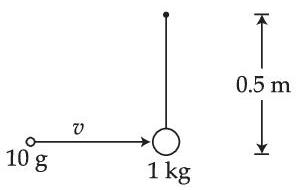

The initial velocity of the particle is $$5\sqrt 2 $$ ms-1 and the air resistance is assumed to be negligible. The magnitude of the change in momentum between the points A and B is x $$\times$$ 10-2 kgms-1. The value of x, to the nearest integer, is __________.

[a is an area as shown in the figure]
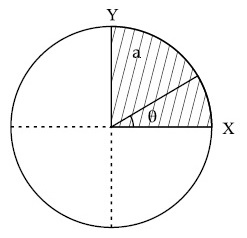
The configuration of pieces after collision is shown in the figure.
The value of $$\theta$$ to the nearest integer is ____________.
